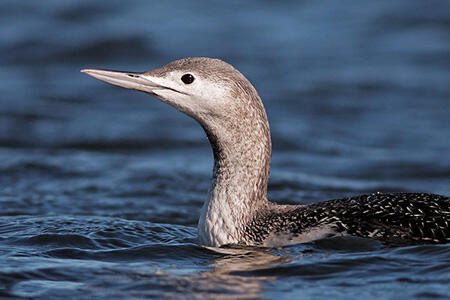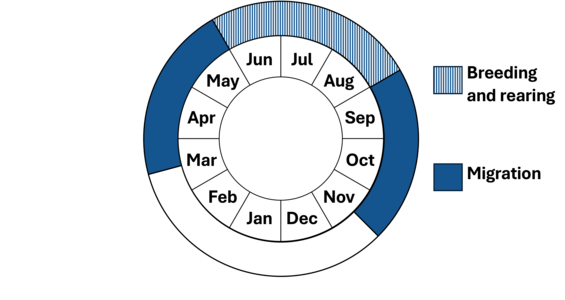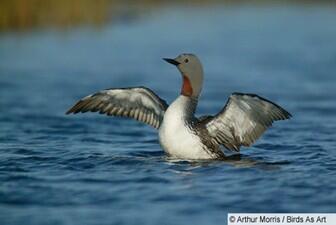- Scientific name: Gavia stellata
Species of Greatest Conservation Need (MA State Wildlife Action Plan)
Description

Red-throated loon
The red-throated loon is the smallest and least robust member of its family, measuring 53-69 cm (21-27 in) in length with a wingspan of 106-116 cm (42-46 in). It is a diving bird with a relatively slender bill used to feed on fish, leeches, mollusks, and aquatic insects. In flight, its feet trail behind the body and appear relatively small compared to those of other loons.
Although the plumage of the sexes is identical, the male is larger and heavier than the female. In breeding plumage, the upperparts are relatively plain, the head is pale gray, and the neck has a dark rust-red throat patch. Nonbreeding plumage is characterized by extensive white on the neck and face and a sharply contrasted dark crown and hindneck.
Life cycle and behavior

Phenology in Massachusetts. This is a simplification of the annual life cycle. Timing exhibited by individuals in a population varies, so adjacent life stages generally overlap each other at their starts and ends.
Red-throated loons are typically present along the Massachusetts coast during the winter months. Their numbers increase during spring and fall migrations, when they are considered common to abundant. These loons generally migrate singly, sometimes in small groups, primarily along the coast a mile or two offshore. They rarely venture onto inland waters south of Canada, except on the Great Lakes, where large numbers may stop during migration. Red-throated loons are monogamous, often forming long-term pair bonds. Both parents share responsibilities throughout the nesting and rearing process. Chicks typically fledge within 7-8 weeks, and families may stay together until fall migration. Both sexes help build a nest, incubate eggs, and care for the young. The nest is made of decayed vegetation, grass, moss, and mud, and is usually constructed in low-lying wetlands near shallow ponds. The average clutch size is two eggs, which are dark olive with blackish-brown blotches. Chicks are born semiprecocial but depend on parents for food for several weeks.
Population status
Despite being unlisted in the Massachusetts Endangered Species Act, this species has experienced localized declines, particularly in areas with high human activity. While globally considered a species of least concern, regional assessments in parts of North America, including Massachusetts, indicate vulnerability due to oil spills, nest predation, and climate-related habitat loss.
Distribution and abundance
The breeding range includes the Alaskan coast and tundra, the coastal plain of northern Canada, and east to Newfoundland. This species prefers the tundra and coastal regions for nesting, but it is also found in mountainous regions and some forested areas.
The red-throated loon generally winters on coastal waters south of the breeding areas and occasionally on inland lakes and rivers near the coast. Along the Atlantic Coast, they winter from Newfoundland to as far south as the east coast of Florida.

Habitat
This loon species prefers to breed in low wetlands, but may also use mountainous areas, bogs, and forested terrain. Nesting ponds tend to be small where this species is sympatric with Pacific loon, but they may be large where red-throated is the only breeding member of its family.
Healthy habitats are vital for supporting native wildlife and plants. Explore habitats and learn about conservation and restoration in Massachusetts.
Threats
Oil spills threaten wintering populations in North America and are potentially devastating to breeding loons during spring or summer. Declines of up to 50% of the population have been reported in some regions, and this may be, at least partially, a result of high nest predation. This species is also susceptible to habitat loss through climate change. Plastic trash in the environment poses a threat as it can be mistaken as food by seabirds and shorebirds and ingested or cause entanglement. Ingested plastics, common for seabirds, can block digestive tracts, cause internal injuries, disrupt the endocrine system, and lead to death. Entanglement from fishing gear and other string-like plastics can cause mortality by strangulation and impairing movements.
Conservation
Conservation efforts should focus on protecting coastal and tundra wetland habitats, monitoring oil spill risks, and mitigating the impacts of climate change on breeding and migratory areas. Public awareness and engagement, combined with long-term monitoring, are essential for sustaining this species across its range. Avoid or recycle single-use plastics and promote and participate in beach cleanup efforts.
References
Barr, J.F., C. Eberl and J.W. Mcintyre. 2000. Red-throated Loon (Gavia stellata), The Birds of North America Online (A. Poole, Ed.). Ithaca: Cornell Lab of Ornithology; Retrieved from the Birds of North America Online: http://bna.birds.cornell.edu/bna/species/513 doi:10.2173/bna.513
Veit, R., and W. Petersen. 1993. Birds of Massachusetts. Massachusetts Audubon Society.
Cornell Lab of Ornithology. “Red-throated Loon.” 2023. All About Birds.
National Audubon Society. “Red-throated Loon.” 2023. Audubon Field Guide.
Contact
| Date published: | April 4, 2025 |
|---|